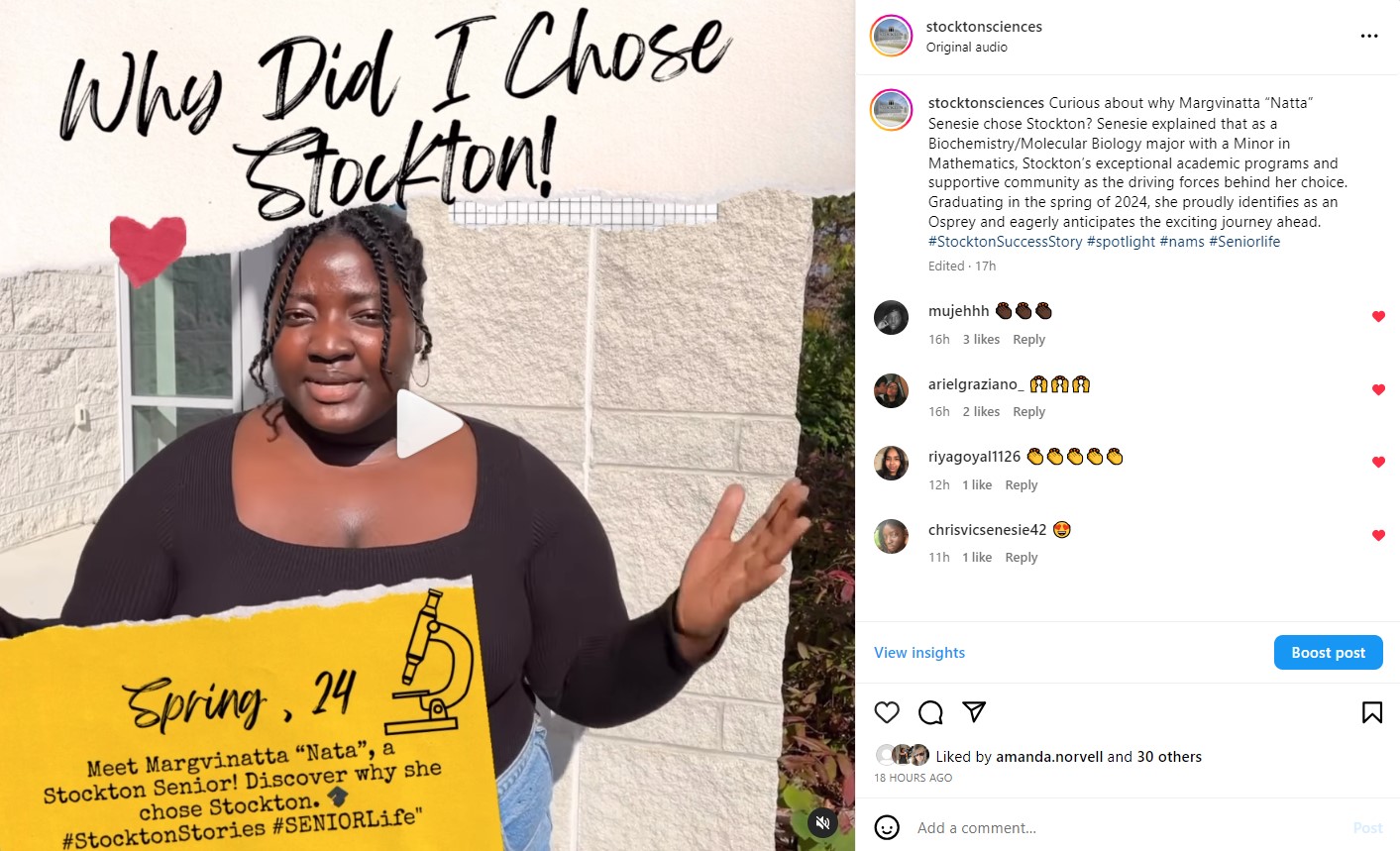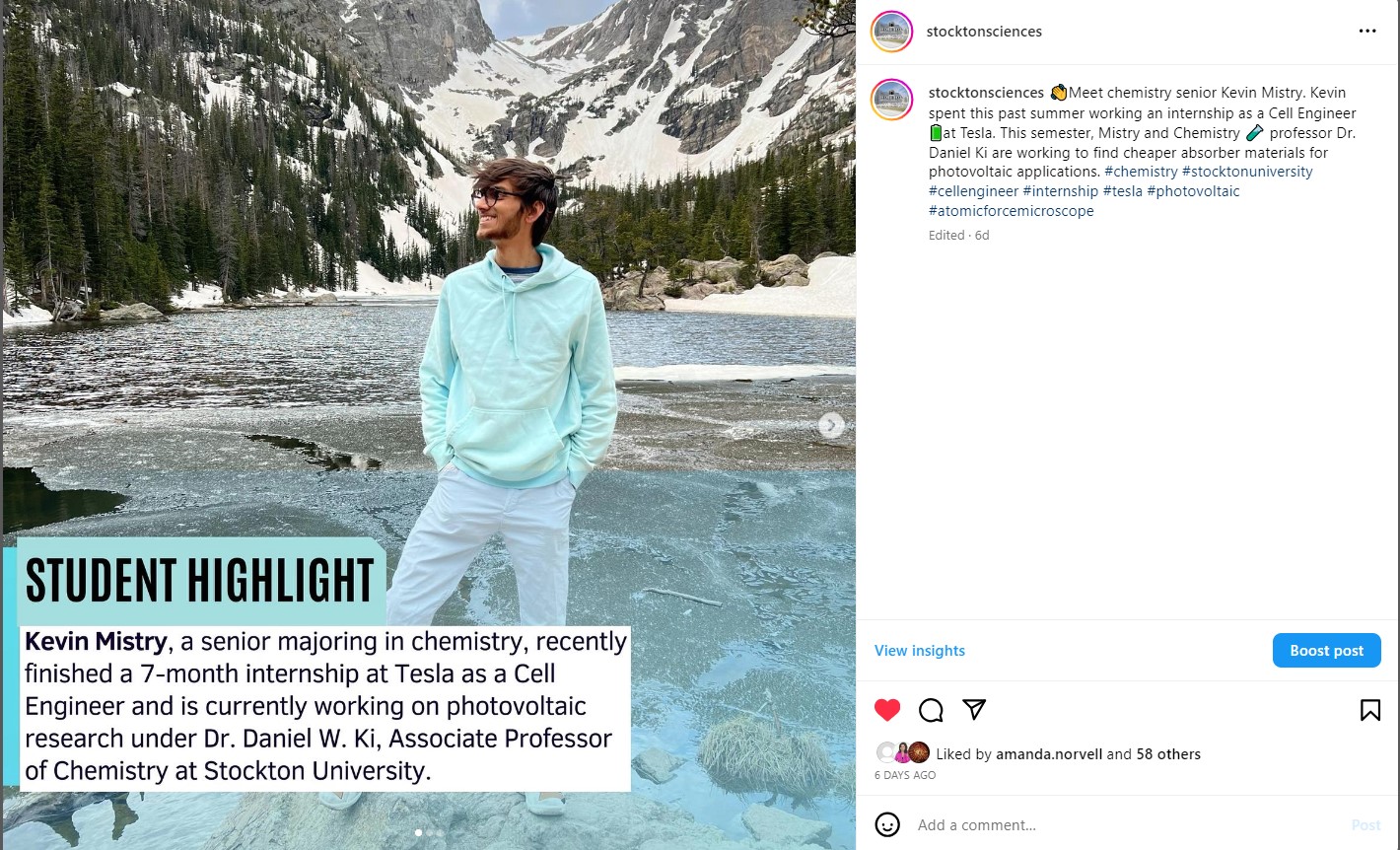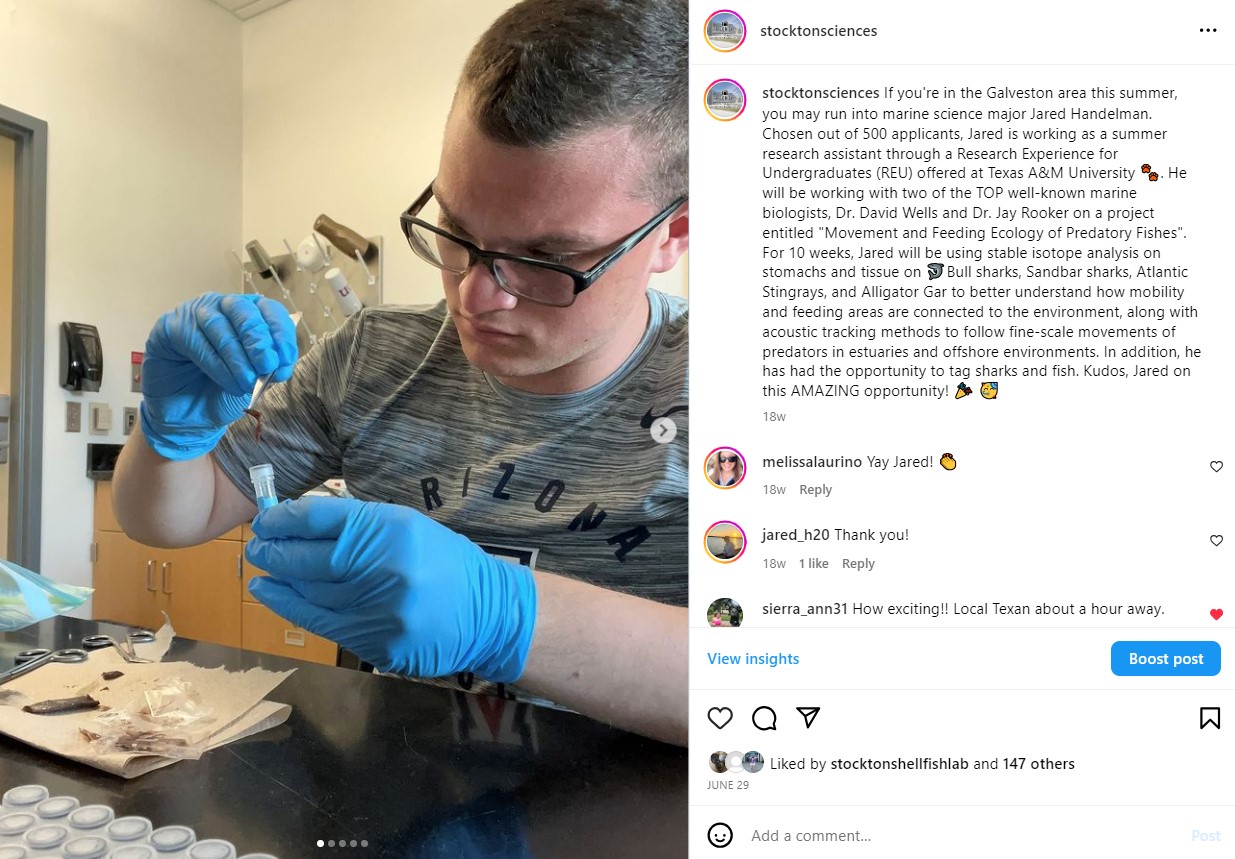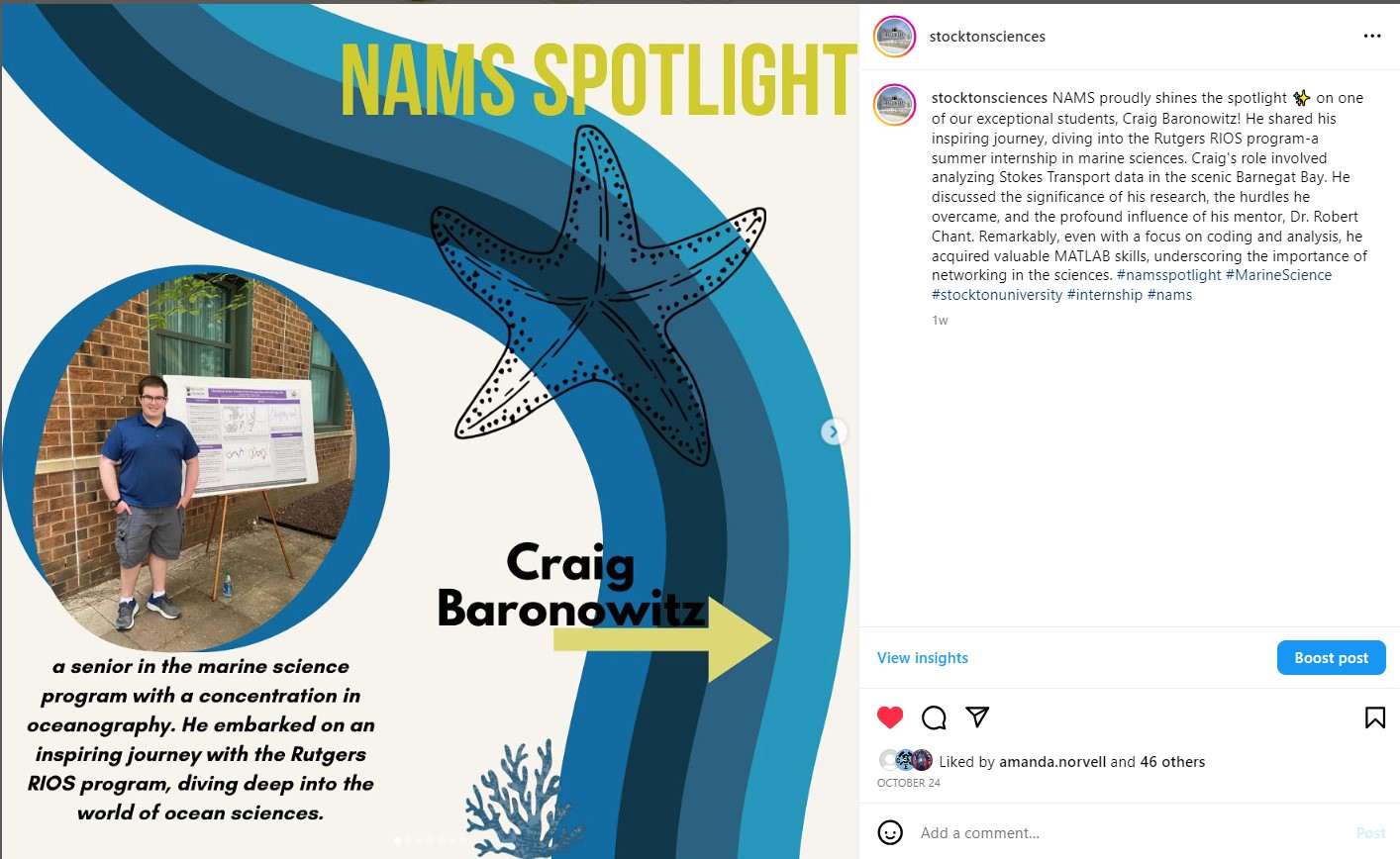Fall 2023 Issue
Get all the latest news on everything NAMS.
September 2022 - September 2023
Highlights
Oysters Help Eelgrass Take Root in the Barnegat Bay
🦪 A young bay scallop sprouts a sticky thread from its shell to cling to a blade of eelgrass—it’s holding on for its life to avoid suffocation on the muddy bay bottom.
Monitoring has revealed eelgrass decline in the Barnegat Bay since 2004, making it harder for the species that depend on the grass for survival, but research is sprouting hope.
Marine creatures in the Barnegat Bay now have a growing seagrass habitat after years of a barren bay bottom following Stockton University’s underwater planting and research project.
Elizabeth Lacey, associate professor of Marine Science, found a shallow water site off Bunting Sedge with just the right amount of sunlight for seagrass to photosynthesize and suitable soil and water characteristics. All that was missing was the eelgrass.
Steven Shaak's Entomology Class Explores the Insects🐛

🔭New Telescope Offers a Look 'Deeper into the Heavens'
The new telescope at the Harold E. Taylor Observatory may only be one inch larger, but it’s light years better, said Stockton Physics Professor Joseph Trout.
The 17-inch PlaneWave CDK17 telescope was officially unveiled to the public on Oct. 20 before a crowd of more than 100 alumni and supporters who got the chance to view the rings of Saturn and the moons of Jupiter on a clear, cool night.
Entering a 🌱 Budding Industry: Fall Cannabis Career Fair
Vendors from all over New Jersey came to talk to Stockton students about the cannabis industry and how to get involved on Nov. 1 in the Campus Center.
In partnership with the New Jersey CannaBusiness Association, the third annual Cannabis Career Fair and Business Expo offered job and internship opportunities for interested students.
⚛ Physics Lessons Aren't Always Equations on the White Board

Stockton Biology Professor 'Inspired' Music Album
You might think it’s a little unusual for a scientist to also be a singer/songwriter.
But for Stockton Biology Professor Matthew Bonnan, the two professions don’t seem that far apart.
“I enjoy being inspired by art,” the Hammonton resident said. “Art is just as important as science because it’s all part of what makes us human, and it’s all part of what draws us together.”
That sense of togetherness is one of the goals that Bonnan is trying to achieve with the release this month of a new album of 12 original songs titled “Once Upon Deep Time.” Bonnan has used his primary field of paleontology to tell a story through music about how sound connects us to the past.
“There is some science content in there, but it’s not supposed to be a K-12 lesson,” he said. “It’s supposed to get people to stop for a moment and go, ‘I didn’t know that. That’s interesting.’ Maybe that encourages some people to look into things further.”
📰 In the News: Patch.com
 Anyone Can Become a Scientist at Sciencepalooza
Anyone Can Become a Scientist at Sciencepalooza
Freshman and sophomore students from Cumberland Regional High School and Camden County Technical Schools (CCTS) had the opportunity to learn about Stockton and various careers in the STEM fields as part of Sciencepalooza on Jan. 5.
Students participated in workshops on topics such as marine science and biology, all led by Stockton’s School of Natural Sciences and Mathematics (NAMS) faculty. In the workshops, the high schoolers:
- Examined the internal and external anatomy of oysters with Christine Thompson, associate professor of Marine Science
- Learned how we encounter rocks and minerals everywhere in our daily lives with Matthew “Rocky” Severs, associate professor of Geology
- Looked through microscopes and observed the cells of animal brains with Nathaniel Hartman, associate professor of Biology
- Diagnosed metabolic diseases of amino acids with Kelly Keenan, professor of Chemistry
- Used wave flumes (tanks of colored water) to explore the physics of beach erosion with Anna Pfeiffer-Herbert, associate professor of Marine Science
Sciencepalooza was born out of the COVID-19 pandemic. In an effort to connect with students, the NAMS department created a virtual program that allowed professors to “visit” high schools and conduct different lessons in science, technology, engineering and mathematics.
Adriane Sicknick of the NAMS department said the online program was successful, especially after collaborating with Malcolm X. Shabazz High School of Newark for monthly STEM fairs. Once programs began to appear back in person, Sicknick and the NAMS faculty were eager to continue what they started online on campus.
🌊 A Look Back on Five Decades of NJ Coastal Research
At 28 years old, Stewart Farrell “went out on a limb” during a job interview at Stockton State College and proposed an idea that would shape the Marine Science program and draw the state’s most dynamic picture of New Jersey’s ever-changing coastline.
When Farrell first heard about Stockton, he was a doctoral student studying coastal processes along Maine’s rocky shoreline. Stockton’s entire staff of eight administrators all fit into the Scott House, a former home that was converted into offices for the founders.
There was an opening for a teaching position in the Marine Science department, and Farrell, who described himself as ABD (all but dissertation), was looking for a job.
During the interview, “I said, look, there’s more to marine science than biology. There are tides, currents, waves and storms, and basically the physical processes control the biology. Not the other way around.”
They listened to his advice, and Stockton’s marine science program now had its first
marine geology professor.
Stockton and Monmouth Partner on Coastal Zone Management
Students interested in pursuing an advanced degree in Coastal Zone Management at Stockton have another point of entry through a new agreement with Monmouth University.
Stockton launched a graduate program in Coastal Zone Management in 2020. Through the new articulation agreement, up to five qualified students earning bachelor’s degrees in Biology or Marine and Environmental Biology and Policy from Monmouth may be admitted to the Coastal Zone Management program.
“We are very excited to enter into this agreement and welcome Monmouth University students interested in coastal zone management to our program,” said Amanda Norvell, dean of the School of Natural Sciences and Mathematics at Stockton.


 Biology Professor Matthew Bonnan is receiving more attention for his new music album,
"Once Upon Deep Time."
Biology Professor Matthew Bonnan is receiving more attention for his new music album,
"Once Upon Deep Time."  Check out the full story by 6ABC.
Check out the full story by 6ABC.
Join a live performance on Monday, November 13 | 8 PM CC Main Theater
🍁Maple Project Sweetens Learning at Local Schools
Growing up in Absecon, Debby Sommers loved being outside.
“I loved nature as a kid, but we didn’t call it that. It was just going outside,” said the retired Galloway Township Middle School science teacher. “We fished and crabbed and watched turtles lay their eggs and ducks bring their babies up so we could feed them Cheerios.”
But she said she wasn’t taught about the Pine Barrens or environmental science until she went to college.
“It wasn’t until I went to Stockton that I fell in love with environmental science and learned to appreciate the unique ecosystems we live in,” said the 1977 graduate.
Part of that unique ecosystem is the Stockton Maple Project. The program began three years ago and is funded by two United States Department of Agriculture grants totaling more than $900,000 to promote maple sugaring in South Jersey.
📰 In the News: The Press of Atlantic City
Spotlight On: Steve Evert

Steve Evert, director of the Marine Field Station (MFS), was recently appointed president-elect for the Northeastern Association of Marine and Great Lakes Laboratories (NEAMGLL). NEAMGLL is one of three regional sections of the National Association of Marine Laboratories (NAML). This leadership role reflects the passion he has not only for his field of expertise, but the impact experiential learning at the MFS has on Stockton students. Evert, who began his career at Stockton over 27 years ago, shares some insights about his time here at Stockton and his thoughts on this new role
Physics Students Using Tomatoes to Study Urban Heat Island Effect
Science majors worked with the Newman Club Catholic Campus Ministry to cook the results of a research project to help feed the homeless. Physics Professor Joseph Trout and Katelyn Brink, a math major, used tomatoes to study the urban heat island effect.

Stockton Helps National Geographic Drain the Oceans

Stockton's Marine Field Station and the R/V Petrel, equipped with multibeam sonar and an ROV camera, were transformed into a TV film set over the summer while Stockton experts were filmed for an episode of National Geographic's Drain the Oceans.
The historical docuseries takes viewers around the world to reveal submerged mysteries with CGI technology and then pieces together clues discovered in the depths with the expertise of marine archaeologists.
Stephen Nagiewicz, an adjunct instructor of Marine Science and a diver, is a featured expert in the second episode of season six, centered on the rise of the mob.
Steve Evert, director of the Marine Field Station, was the captain of an expedition that took the film crew offshore with Nagiewicz and Peter Straub, professor of Biology, to explore where Prohibition deliveries secretly unfolded and to return to the wreck he dove three decades ago.
The episode aired March 12 on Disney+.
🎬 Check out the trailer here.
➡️Littoral Society Tagging Data Poster Shown at the Mid-Atlantic Chapter AFS Conference
Marine Science major Jared Handelman presented his tagging data at the Mid-Atlantic Chaper AFS Conference.

Stockton Dives into Prohibition History with National Geographic
Stephen Nagiewicz, an adjunct instructor of Marine Science at Stockton, tucked a sketch of a shipwreck between the pages of a logbook for safekeeping. He knew the amber flasks poking up like gravestones on the seafloor were all that remained of a story worth telling, but how the details of the crew and mission would be uncovered was still a mystery.
Thirty-five years later, he got a phone call that would end up deploying multibeam sonar, an ROV, divers, a film crew with cameras in the air and sea, and computer-generated imagery (CGI) to reconstruct the ship and its secret role in prohibition for a season 6 episode of National Geographic’s docuseries “Drain the Oceans.”

Four Professors Present Last Lectures Before Retiring 👋🏽
Four Stockton professors had one final chance to impart some wisdom to the campus community on April 6 during the second annual Last Lecture.
Each professor had about a half hour to talk about anything they wanted, even if it sometimes had little to do with what they had taught during their time at Stockton.
NAMS Professors:
- Karen York, professor of Biology. She arrived at Stockton in 1995 and has specialized in microbiology and molecular genetics.
- Juan Tolosa, professor of Mathematics. He came to Stockton in 1986. He’s taught a wide range of classes, including Geometry, Calculus and Russian.
Nearly $700,000 Grant Will Tag N.J. Harbor Seals for First Time ( =ᴥ= )
Everyone has seen bottlenose dolphins swimming near beaches in the summer. You might also catch a humpback whale or two off the coast.
But did you know that harbor seals also have a regular seasonal home in South Jersey?
A lot of people aren’t aware that harbor seals occur in New Jersey,” said marine mammal biologist Jackie Toth Sullivan, who’s also an adjunct faculty member at Stockton. “This is likely because seals are here in large numbers during the winter months. There aren’t that many people on the beach or on the water in January, February or March.”
Sullivan said for years, as many as 360 seals have gathered to rest and forage in Great Bay — the largest haul-out site in New Jersey. Two other known haul-out sites include Sandy Hook State Park (about 100 seals) and Barnegat Light on Long Beach Island (about 30 seals). The seals begin to gather in October and November and usually stay through March or April in large numbers, she said
Mia Zeringo brought to tears 💧 when her Intro to Marine Biology class caught a Smooth Dogfish during a trawling survey.

Return of 🌊 Coast Day Brings Lifelong Memories to Students
Juan Aponte admitted he’s “not an underwater kind of person.”
“What lurks under the water, it kind of frightens me,” said the Atlantic City High School senior.
But after seeing how a remotely operated submersible can take video of a shipwreck at the bottom of the ocean, his perspective might be changing.
Aponte and several of his classmates spent the morning of Oct. 20 at Coast Day, an event coordinated by Susanne Moskalski, associate professor of Marine Science, and held at John F. Scarpa Academic Center. Students from Atlantic City and Egg Harbor Township high schools checked out a variety of displays and exhibitors focusing on the theme of coastal change, conservation and resilience. The students also listened to a lecture about sea level rise, had the opportunity to take part in a craft with shells and even learned how to cast a fishing rod.
📸 View more photos on Flickr.
National Science Foundation Grant Helps Stockton Study Inlets 🌊
Anna Pfeiffer-Herbert, associate professor of Marine Science, studies the exchange of water between the ocean and the bay through inlets. This summer, she and a team of research interns are looking at the two inlets flanking the 18-mile stretch of Long Beach Island with funding from a $155,000 grant from the National Science Foundation.
Pfeiffer-Herbert, who grew up in Acme, WA and now resides in Galloway, uses a simple analogy to explain the importance of understanding how long it takes water to exit the bay through an inlet.
The flushing rate in the bay impacts the health of the ecosystem that wildlife and humans depend on for habitat, recreation, commercial fishing and ecotourism.
The combination of a data set that describes water quality and a data set that describes how fast water flushes out of the bay at two different inlet types allows researchers to better understand how inlets work.
The research team is working with the Stockton Marine Field Station to collect water velocity and water quality data at both inlets.

- Shark attack survivor shares her story, 'plans to enjoy beach not water'
- History of South Jersey Jewish Farming Colony Brough to Life at Stockton
- Stockton's Marine Field Station recommended for $1.4M marine debris
- Sweet News: Maple Syrup Program at Stockton Expands to Local Schools
-
Galloway Township adopts rules for indoor pot businesses, but outdoor crops still debated
- Opinion: Why are Whales Dying? It's not because of offshore wind
- Otters as big as lions, there were. As big as grizzly bears.
- Cannademix's Restore the Shore Event Brought Cannabis Education Jackpots to New Jersey's Atlantic City
- See Why "Everyone Loves Maple Syrup" at Tuckerton Library Association's Annual Luncheon
- Stockton to Host Cannabis Fair
- News of SF Fandom
- Community Report From the Biosignatures Standards of Evidence Workshop
- Want to Work with Weed?
- Stockton Students Become the Teachers in Atlantic City
- Stockton Unviersity's observatory gets new telescope
- In Prehistoric Ethiopia, Otters Were as Big as Lions
- Community Report from the Biostandards of Evidence Workshop
- Stockton Students Become the Teachers in Atlantic City
- Cannademix's Restore the Shore Event Brought Cannabis Education Jackpots to New Jersey's Atlantic City
- NJ's Stockton University Hosting Cannabis Career Fair for the Public
- Stockton to Host Cannabis Career Fair and Business Expo
- Stockton University's observatory gets new telescope
- Students Witness Coastal Processes on Little Beach Island
- Stockton Soil Juding Team Digs into Their Major
- Oyster Help Eelgrass Take Root in the Barnegat Bay
- Stockton to Monitor New Mil Creek Oyster Reef
- Spotted Lanternflies Staying Outof Cape May County
- Future Fossils - Dark Microbiology & Right Relations in Science
- Aquaculture Project to Restore Oyster Beds
- ALS Fluke Tagging Aboard the Mi-Jo II
- In Prehistoric Ethiopia, Otters were as Big as Lions
- Violent conflict in Myanamar linked to boom in fossil amber research study claims
- SJ green teams to share what they are doing to tackle food insecurity
- Concerns over sale of Goragsaurus skeleton
- Seven Cannabis Schools of Continuing and Professional Education
- Cool Relief: How the Jersey Shore's sea breeze creates the perfect escape
- Keeping birds in the clear: How N.J. is finding answers to a pressing aviary problem
- Jimmy Johnson's fishing tournament returns to Atlantic City: Shep on Fishing
- The Jersey Shore Sometimes Looks Like the Caribbean and othertimes it's Murky. Here's Why.
- Inspiring a Passion for Fishing
- Best Cannabis Colleges
- Program Gives High School Students In-persn STEM Lab Time
😁Look Who's on NAMS Socials!








